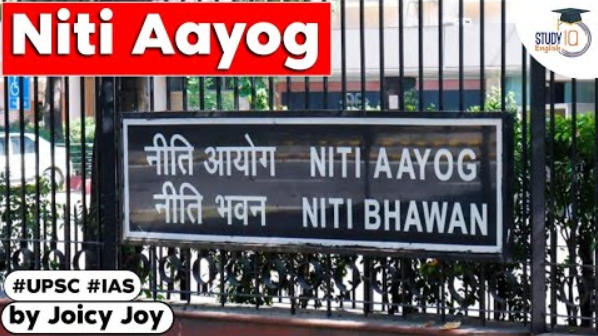Table of Contents
NATIONAL INSTITUTION FOR TRANSFORMING INDIA
- It is the country’s premier policy-making institution that is expected to bolster the economic growth of the country. It aims to construct a strong state that will help to create a dynamic and strong nation. This helps India to emerge as a major economy in the world. The NITI Aayog’s creation has two hubs called “Team India Hub” and “Knowledge and Innovation Hub”.
- Planning Commission was replaced by a new institution – NITI AAYYOG on January 1, 2015 with emphasis on ‘Bottom –Up’ approach to envisage the vision of Maximum Governance, Minimum Government, echoing the spirit of ‘Cooperative Federalism’.
- NITI Aayog Chairman – Narendra Modi
- NITI Aayog Vice-Chairman– Dr. Rajiv Kumar (September 2017 – present) is the current Vice Chairman of the NITI Aayog.
Objectives of NITI AayoG
- The active participation of States in the light of national objectives and to provide a framework ‘national agenda’.
- To promote cooperative federalism through well-ordered support initiatives and mechanisms with the States on an uninterrupted basis.
- To construct methods to formulate a reliable strategy at the village level and aggregate these gradually at higher levels of government.
- An economic policy that incorporates national security interests.
- To pay special consideration to the sections of the society that may be at risk of not profiting satisfactorily from economic progress.
- To propose strategic and long-term policy and programme frameworks and initiatives, and review their progress and their effectiveness.
- To grant advice and encourage partnerships between important stakeholders and national-international Think Tanks, as well as educational and policy research institutions.
- To generate knowledge, innovation, and entrepreneurial support system through a shared community of national and international experts, etc.
- To provide a platform for resolution of inter-sectoral and inter-departmental issues to speed up the accomplishment of the progressive agenda.
- To preserve a state-of-the-art Resource Centre, be a repository of research on good governance and best practices in sustainable and equitable development as well as help their distribution to participants.
- To effectively screen and assess the implementation of programmes and initiatives, including the identification of the needed resources to strengthen the likelihood of success.
- To pay attention to technology improvement and capacity building for the discharge of programs and initiatives.
- To undertake other necessary activities to the implementation of the national development agenda, and the objectives.
FUNCTIONS OF NITI AAYOG
Documents Published by NITI Aayog
- The documents published by NITI Aayog are as follows:
- Fifteen-Year Vision,
- Seven Year Strategy and
- Three-Year Action Agenda.
- The documents containing the Fifteen-Year Vision and Seven Year Strategy is currently under preparation at the NITI Aayog.
THREE YEAR ACTION AGENDA
- The Three-Year Action Agenda is a NITI Aayog document for the period of 2017-18 to 2019-20.
- This document is being published to recommend policy changes and programmes for action from 2017-18 to 2019-20.
- The Action Agenda has been prepared as an integral part of the exercise leading to the Vision and Strategy document. It has been fast-tracked and released first, keeping in view that with the start of the fiscal year 2016-17, it is of immediate relevance for policy implementation.
- The Three-Year Action Agenda offers ambitious proposals for policy changes within a relatively short period.
NITI Aayog – Achievements
- In the report 2019-20 mentions the achievements of Niti Aayog:
- Monitoring and Analyzing Food and Agricultural Policies (MAFAP) programme in India – It is a collaborative research project between Niti Aayog and the United Nations’ Food and Agriculture Organization (FAO).
- It aims to monitor, analyze and reform food and agricultural policies.
- The first phase of the MAFAP programme ran between 23rd September and 31 December 2019.
- National Agriculture Price Policy and National Food Security Policy for selected agricultural product marketing committees and districts respectively were reported.
- The second phase of the MAFAP programme is scheduled between 1st January 2020 and 31st December 2021.
- The Niti Aayog governing council promoted Zero Budget Natural Farming.
- Additionally, natural farming is being promoted as ‘Bhartiya Prakritik Krishi Paddhati’ programme under Paramparagat Krishi Vikas Yojana (PKVY).
- Village Storage Scheme has been conceptualised. Similarly, Union Budget 2021 has proposed Dhaanya Lakshmi Village Storage Scheme.
NITI Aayog’s “Strategy for New India @75”
- The document has identified 41 different areas that require either a sharper focus on implementing the flagship schemes already in place or a new design and initiative to achieve India’s true potential.
- Each chapter summarizes the current status of the sector, takes full cognizance of the progress made thus far.
- It then identifies the binding constraints and proposes measures to address these constraints.
- The approach is believed to provide an inventory of readily implementable measures for the government departments and agencies both in the central and state
- The focus is to improve the policy environment so that the contribution of private investors and other stakeholders can be maximized to achieve the goals set out for New India
Q) Which of the following bodies does not/do not find mention in the Constitution? (UPSC Civil Services Preliminary Examination 2013)
- National Development Council
- Planning Commission
- Zonal Councils
Select the correct answer using the codes given below.
- 1 and 2 only
- 2 only
- 1 and 3 only
- 1, 2 and 3
Q) Consider the following statements:(UPSC Civil Services Preliminary Examination 2013)
- National Development Council is an organ of the Planning Commission.
- The Economic and Social Planning is kept in the Concurrent List in the Constitution of India.
- The Constitution of India prescribes that Panchayats should be assigned the task of preparation of plans for economic development and social justice.
Which of the statements given above is/are correct?
- A) 1 only
- B) 2 and 3 only
- C) 1 and 3 only
- D) 1,2 and 3
Indian Economy | Free PDF























 WhatsApp
WhatsApp